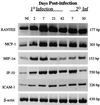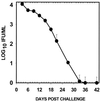Chemokine and chemokine receptor dynamics during genital chlamydial infection
- PMID: 11796619
- PMCID: PMC127682
- DOI: 10.1128/IAI.70.2.844-850.2002
Chemokine and chemokine receptor dynamics during genital chlamydial infection
Abstract
Current design strategies for vaccines against certain microbial pathogens, including Chlamydia trachomatis, require the induction and targeting of specific immune effectors to the local sites of infection known as the mucosal effector sites. Chemokines and their receptors are important mediators of leukocyte trafficking and of the controlled recruitment of specific leukocyte clonotypes during host defense against infections and during inflammation. We analyzed the dynamics of chemokine and chemokine receptor expression in genital mucosae during genital chlamydial infection in a murine model to determine how these molecular entities influence the development of immunity and the clearance of infection. A time course study revealed an increase of up to threefold in the levels of expression of RANTES, monocyte chemotactic protein 1 (MCP-1), gamma-interferon-inducible protein 10 (IP-10), macrophage inflammatory protein 1alpha (MIP-1alpha), and intercellular adhesion molecule type 1 (ICAM-1) after genital infection with the C. trachomatis agent of mouse pneumonitis. Peak levels of expression of RANTES, MCP-1, and MIP-1alpha occurred by day 7 after primary infection, while those of IP-10 and ICAM-1 peaked by day 21. Expression levels of these molecules decreased by day 42 after primary infection, by which time all animals had resolved the infection, suggesting an infection-driven regulation of expression. A rapid upregulation of expression of these molecules was observed after secondary infection. The presence of cells bearing the chemokine receptors CCR5 and CXCR3, known to be preferentially expressed on Th1 and dendritic cells, was also synchronous with the kinetics of immune induction in the genital tract and clearance of infection. Results demonstrated that genital chlamydial infection is associated with a significant induction of chemokines and chemokine receptors that are involved in the recruitment of Th1 cells into the site of infection. Future studies will focus on how selective modulation of chemokines and their receptors can be used to optimize long-term immunity against CHLAMYDIA:
Figures






Similar articles
-
The role of chemokines and their receptors in the rejection of pig islet tissue xenografts.Xenotransplantation. 2003 Mar;10(2):164-77. doi: 10.1034/j.1399-3089.2003.01146.x. Xenotransplantation. 2003. PMID: 12588649
-
Chemokine expression during the development and resolution of a pulmonary leukocyte response to influenza A virus infection in mice.J Leukoc Biol. 2004 Oct;76(4):886-95. doi: 10.1189/jlb.1203644. Epub 2004 Jul 7. J Leukoc Biol. 2004. PMID: 15240757
-
Modulation of experimental autoimmune encephalomyelitis: effect of altered peptide ligand on chemokine and chemokine receptor expression.J Neuroimmunol. 2000 Oct 2;110(1-2):195-208. doi: 10.1016/s0165-5728(00)00351-9. J Neuroimmunol. 2000. PMID: 11024550
-
The role of chemokines as inflammatory mediators in chronic hepatitis C virus infection.J Viral Hepat. 2007 Oct;14(10):675-87. doi: 10.1111/j.1365-2893.2006.00838.x. J Viral Hepat. 2007. PMID: 17875002 Review.
-
Leukocyte recruitment during pulmonary Cryptococcus neoformans infection.Immunopharmacology. 2000 Jul 25;48(3):231-6. doi: 10.1016/s0162-3109(00)00222-8. Immunopharmacology. 2000. PMID: 10960662 Review.
Cited by
-
Intravaginal immunization of mice with recombinant Salmonella enterica serovar Typhimurium expressing human papillomavirus type 16 antigens as a potential route of vaccination against cervical cancer.Infect Immun. 2008 May;76(5):1940-51. doi: 10.1128/IAI.01484-07. Epub 2008 Mar 10. Infect Immun. 2008. PMID: 18332214 Free PMC article.
-
Effects of prime-boost strategies on the protective efficacy and immunogenicity of a PLGA (85:15)-encapsulated Chlamydia recombinant MOMP nanovaccine.Pathog Dis. 2024 Feb 7;82:ftae004. doi: 10.1093/femspd/ftae004. Pathog Dis. 2024. PMID: 38862192 Free PMC article.
-
CXCR3 and CCR5 are both required for T cell-mediated protection against C. trachomatis infection in the murine genital mucosa.Mucosal Immunol. 2011 Mar;4(2):208-16. doi: 10.1038/mi.2010.58. Epub 2010 Sep 15. Mucosal Immunol. 2011. PMID: 20844481 Free PMC article.
-
Chlamydial infection increases gonococcal colonization in a novel murine coinfection model.Infect Immun. 2011 Apr;79(4):1566-77. doi: 10.1128/IAI.01155-10. Epub 2011 Jan 18. Infect Immun. 2011. PMID: 21245268 Free PMC article.
-
Chemokine-mediated immune responses in the female genital tract mucosa.Immunol Cell Biol. 2015 Apr;93(4):347-54. doi: 10.1038/icb.2015.20. Epub 2015 Mar 17. Immunol Cell Biol. 2015. PMID: 25776842 Review.
References
-
- Baggiolini, M., B. Dewald, and B. Moser. 1997. Human chemokines: an update. Annu. Rev. Immunol. 15:675–705. - PubMed
-
- Bonecchi, R., G. Bianchi, P. P. Bordignon, D. D’Ambrosio, R. Lang, A. Borsatti, S. Sozzani, P. Allavena, P. A. Gray, A. Mantovani, and F. Sinigaglia. 1998. Differential expression of chemokine receptors and chemotactic responsiveness of type 1 T helper cells (Th1s) and Th2s. J. Exp. Med. 187:129–134. - PMC - PubMed
-
- Colle, J. H., P. B. Falanga, M. Singer, B. Hevin, and G. Milon. 1997. Quantitation of messenger RNA by competitive RT-PCR: a simplified read out assay. J. Immunol. Methods 210:175–184. - PubMed
Publication types
MeSH terms
Substances
Grants and funding
LinkOut - more resources
Full Text Sources
Other Literature Sources
Medical
Research Materials
Miscellaneous

